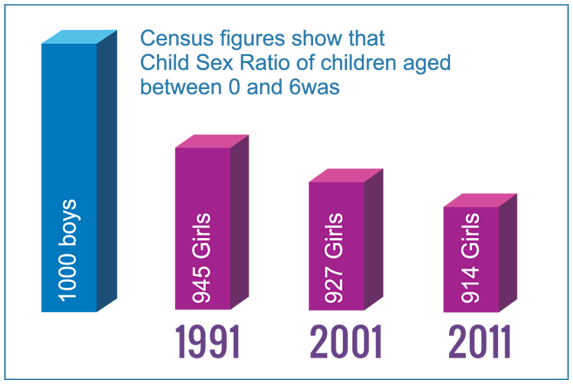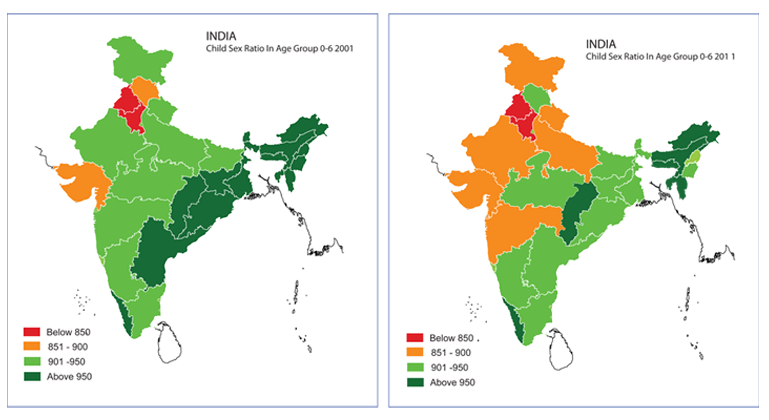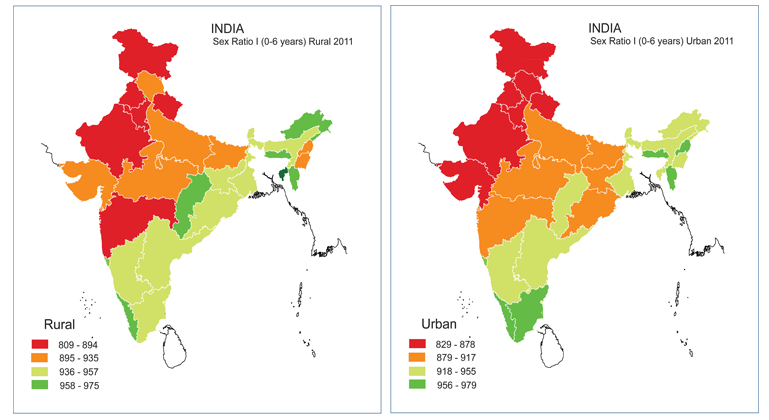Present Scenario
 The present scenario is frightening. After the sex of the foetus is determined through ultrasound scan, or amniocentesis, the family decides to abort the child if it is female. If the time for safe abortion, which is up to three months of pregnancy, is over, chemical injection is given to kill the baby and induce miscarriage. As this procedure costs over Rs.60,000/- in India, only the rich people can have recourse to this method. Research papers on the trends in developing countries prove that the richer people get the more selective abortions take place. A heart-rending fact is that babies who fight the poisoning by chemical injections and manage to be born are usually deformed or disabled and lead a life of untold misery for themselves and their families.
The present scenario is frightening. After the sex of the foetus is determined through ultrasound scan, or amniocentesis, the family decides to abort the child if it is female. If the time for safe abortion, which is up to three months of pregnancy, is over, chemical injection is given to kill the baby and induce miscarriage. As this procedure costs over Rs.60,000/- in India, only the rich people can have recourse to this method. Research papers on the trends in developing countries prove that the richer people get the more selective abortions take place. A heart-rending fact is that babies who fight the poisoning by chemical injections and manage to be born are usually deformed or disabled and lead a life of untold misery for themselves and their families.
The total population of India recorded an increase of 181 million in the decennial period from 2001-2011, while the number of children aged 0 to 6 years came down by 5.05 million during the same period. What is more disturbing is that the fall in male children is only just above 2 million (2.06), while that of female children is almost 3 million (2.99).
The falling child sex ratio in India is clearly evident in the statistics gathered through the decennial census operations. Child Sex Ratio, the number of female children per 1000 male children, between the age of 0 and 6, which stood at 976 in 1961, fell to 945 in 1991, 927 in 2001 and 914 in 2011.

Even with a slight improvement in the condition in some states, after the alarm was sounded at the dawn of the new millennium, the figures for Census 2011 are really frightening. The North-West region and the heartland of India are the worst hit with Jammu & Kashmir, Uttar Pradesh, Uttarakhand, Haryana, Punjab, Chandigarh, Rajasthan, Gujarat and Maharashtra remaining below 900, i.e., less than 900 girls per 1000 boys in the age group of 0 to 6. Of these, Haryana and Punjab are below 850.

There is another aspect of this fall that greatly differs from earlier figures. The rural areas had been comparatively safe from the doctors and scanning centres indulging in this ‘business’ of foeticide. But the 2011 figures show that scanning centres with their mobile units, manned with qualified doctors, have been reaching into villages for expanding their ‘business’. That is why, the rate of drop in Child Sex Ratio in the rural areas is three times the rate in the urban areas during 2001-2011, although the ratio for rural India is still 17 (at 919) points higher than the ratio of 902 for urban India.
| Child (0-6 years) Sex Ratio: 1991-2011 - India | |||
| Census year | Total | Rural | Urban |
| 1991 | 945 | 948 | 935 |
| 2001 | 927 | 933 | 906 |
| 2011 | 914 | 919 | 902 |

There has been an increase also in the number of districts in rural areas where the child sex ratio is critically very low, i.e., below 850. In 2001, there were just 54 districts with a ratio below 850 and in 2011 there were 74. The number of districts with a ratio below 900 increased during this period from 61 to 188. The number of districts with a ratio above 1000 was only 12 in the whole of rural India in 2011.
| Child Sex Ratio – Distribution of Districts in Rural and urban India | |||||
| Districts by ranges of Child Sex Ratio in Rural India, 2001- 2011 | Districts by ranges of Child Sex Ratio in Urban India, 2001- 2011 | ||||
| Ranges of CSR (0-6 years) | Census Years | Ranges of CSR (0-6 years) | Census Years | ||
| 2001 | 2011 | 2001 | 2011 | ||
| Total | 640* | 640 | Total | 640* | 640 |
| Nil (No rural) | 9 | 9 | Nil (No urban) | 18 | 9 |
| Up to 850 | 54 | 74 | Up to 850 | 86 | 59 |
| 851-900 | 61 | 188 | 851-900 | 110 | 121 |
| 901-999 | 500 | 363 | 901-999 | 417 | 447 |
| 1000+ | 16 | 12 | 1000+ | 9 | 4 |
The statistics of sex ratio at birth gives us separate figures for foeticide without mixing up the cases of infant mortality, including infanticide, between the ages 0 to 6. The Sample Registration System (SRS) figures for 2008-2010 gives the figures for Punjab as 832 and Haryana as 848, as could be expected, but the figure for Kerala at 966 is a real eye-opener. This state, which had been giving birth to girls and boys almost equally, a few decades ago, has started to give in to the temptations of female foeticide. Just like Kerala, many new areas are succumbing to the ‘attractions’ of female foeticide as the figures for Tamil Nadu shows a decline of 19 in sex ratio at birth between the figures for 2002-2004 and 2008-2010. However, the hectic intervention by the Government and other agencies and organisations has resulted in an increase in sex ratio at birth in some major states raising the figures for the country as a whole.


